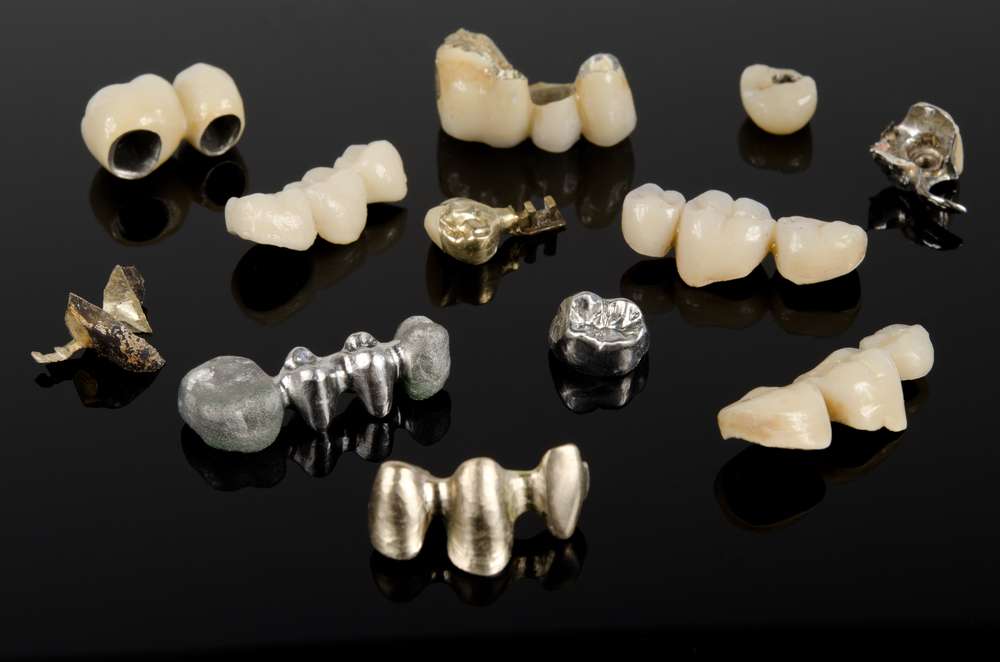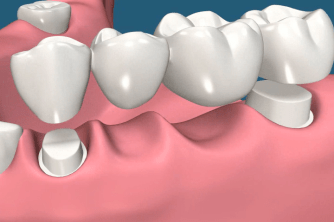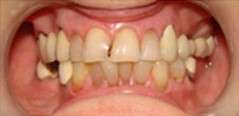


A dental crown is a tooth cap placed to cover the tooth to restore its shape, its size and its strength. A bridge is a combination of crowns. Metal ceramic crowns also known as porcelain fused to metal crowns have an inner layer of metal to which tooth colored ceramic is fused at high temperature. Dental bridges are meant to replace missing teeth by “bridging” the gap between two remaining teeth. The crowns are fitted over the remaining teeth to hold the false tooth in place. When there are only teeth on one side of the gap, cantilever bridges may be given. Cantilever bridges consist of two side-by-side crowns and only one is connected to the missing tooth.
Who needs dental crowns?
* Protect a weak tooth (for instance, from decay) from breaking especially after an RCT
* Restore an already broken tooth or a tooth that has been severely worn down
* Cover and support a tooth with a large filling when there isn’t a lot of tooth left
* Hold a dental bridge in place
* Cover misshaped or severely discolored teeth
* Over a dental implant
Which type of dental crown is best?
This would depend on the area of the mouth where the crown is placed. For anterior teeth, metal free crowns would give the best aesthetic results. For posterior teeth, if sufficient occlusal clearance is available both metal ceramic and metal free zirconia crowns are advisable. For teeth with very limited occlusal clearance, all-metal crowns are advisable.
What is the longest lasting dental crown?
All metal crowns are the longest lasting dental crowns.
What is the healthiest type of crown?
Gold metal is considered highly tissue friendly and hence pure gold growns are considered the “healthiest” type of crowns.
What materials are used to make a crown?
Metal-Ceramic Crown / Metal-Porcelain Crown
They combine the strength of the metal along with the esthetics of porcelain. Of course, the porcelain is slightly more prone to chipping, but they are still tough. There are different types of porcelain fused to metal dental crowns. There is a choice in the metal:-
- Precious alloy (89-92% gold alloy, yellow gold color)
- Semi-precious alloy (54-62% gold alloy, “white gold”)
- Non-precious (metal alloys, stainless steel color)
Captek Crown
Precious alloys with high gold and platinum content are most preferable. One such crown that is commonly used today is called Captek. The advantages of using Captek are many:-
- Provides the most extreme combination of strength and esthetics.
- Truly the most beautiful metal-based crowns and are highly recommended for all areas of the mouth, front or back.
- Biocompatible: Captek’s advanced gold material reduces the accumulation of harmful bacteria at the gum line by 90% compared to natural tooth structure.
- Superior fit: Captek fit is superior to all other restorations.
- No Black lines at Gum Margins: The light-dispersion effects of Captek crowns are designed to mimic those of healthy natural tooth structure. There is no oxidation, so it will not lead to black lines at the gum margins.
- Versatility of use: can easily be used for single crowns, implants, and bridges both anteriorly and posteriorly.
The only reason we have gone away from gold under our porcelain fused to metal crowns is the high cost of gold.
Semi-precious metal offers a balance between esthetics and strength at a lower cost than precious metals. It resists oxidation, it casts more accurately than non-precious metal, and it is a very commonly chosen option. But it cannot provide the warmth and beauty of gold-lined porcelain crowns.
Non-precious alloys are made of low-cost metals and have been in use for many decades. They are more difficult to cast (shape) than softer precious metals and therefore offer a less precise fit. Non-precious alloys also tend to oxidize over time) which darkens their color even more and can even stain and “tattoo” the gum.
Ceramic Crown
The materials used in fabricating metal free crown depend on the area where it will be placed in the mouth. In the anterior region of the mouth, where cosmetics are of prime concern, Lithium disilicate ceramic materials are preferred for their high translucency. However, they lack enough strength to bear chewing forces when used in posterior part of mouth.
In these areas, zirconia based metal ceramic crowns are the materials of choice due to their high strength. Esthetically, they are good too but being opaque, they are slightly inferior compared to lithium disilicate ceramic in areas with high cosmetic needs.
Metal Ceramic Crown
Metal ceramic crowns are double layered crowns – the inner layer is of metal on which an outer layer of tooth colored ceramic is fused. The metal may be non –precious (cobalt chromium alloy), semi-precious (gold, silver along with other metals) or precious (gold). Metal ceramic crowns have been in usage in dentistry for decades. They combine the strength of metal along with the cosmetics provided by porcelain which is fused over the metal. One had the choice of metal- non precious metal (alloy of cobalt and chromium), Semi-precious alloy (made of gold, silver, palladium along with non-precious ,metals) and precious metal (gold and platinum). In all, it provided solutions matching every budget.
Precious metal fused to ceramic crowns are still the most preferred because gold is the most biocompatible metal to gum tissue. The only reason of being not so popular is the high cost associated with their fabrication. However, metal ceramic crowns have few limitations too.They tend to break or chip easily. The chipping occurs of the porcelain portion of the crown. They are not compatible with MRI (of head and neck region)
Metal Ceramic Crowns FAQs
What are the benefits of metal ceramic crowns?
Metal ceramic combine the advantage of aesthetics and low cost (compared to metal free crowns).
How long do metal ceramic crowns last?
With proper hygiene and maintenance, metal ceramic crowns can last you for decades.
How are metal ceramic crowns placed?
For metal ceramic crowns, first tooth preparation is done and impressions are taken. Crowns are then sent to the dental laboratory for fabrication. Once made, metal ceramic crowns are fixed on the tooth by special dental cement.
Are metal ceramic crowns more expensive than other types of crowns?
Metal ceramic crowns are more expensive than nonprecious metal crowns. Precious metal ceramic crowns are more expensive than even metal free crowns!
Can metal ceramic crowns be used on any tooth?
Metal ceramic crowns are double layered crowns-an inner layer of metal and an outer layer of tooth-colored ceramic. Being double layered, they need a minimum thickness of 1.5mm. In teeth with short gingiva-occlusal height, where an occlusal clearance of 1.5mm is not possible, metal ceramic crowns cannot be used.
How do I care for my metal ceramic crown?
Regular brushing, mouth rinsing and flossing is indicated on a regular basis. In addition, professional scaling is recommended every 6 months.
Can metal ceramic crowns cause allergies?
For those who are allergic, the metallic part in metal ceramic crowns can cause allergy. Allergy to metals nickel, cobalt and chromium is well known.
Are there any alternatives to metal ceramic crowns?
Alternatives to metal ceramic crowns include metal crowns (non-precious, semi- precious and precious metal crowns) and metal free crowns.
Are metal ceramic crowns covered by dental insurance?
Metal ceramic crowns are included under cosmetic dental procedures and hence not covered by dental insurance.
Metal-Free Ceramic Crown (Zirconia Crowns)


Before
After
Ceramic Crowns (Zirconia Crowns)
Zirconia crowns have largely replaced metal ceramic crowns as they offer numerous benfits over the latter. These are the best-looking crowns, and probably the best value for your money as far as esthetics are concerned. Contrary to what might appear, these materials are extremely strong and fracture tough. They can be conveniently and reliably used in any part of the mouth. These are also the preferred material of choice in patients with metal allergies. Zirconia crowns and bridges restorations uses the latest CAD/CAM technology ensuring precision of fit.
- No PFM ‘gray lines’ ever: With metal ceramic, soft tissue around the tooth can recede, over time, revealing the metal underneath as ugly gray lines. This simply can’t happen with metal-free Zirconua restorations.
- Bio-compatible: All-ceramic solutions are completely tissue-friendly. These crown, bridge or veneer (laminate) integrates beautifully with its surroundings, encouraging gum to grow back up to the tooth, as it would naturally. And because they are bio-compatible, there are no allergic reactions, no sensitivity to temperature and no impact on taste.
- Perfect fit: Metal free crowns are precision-engineered in state-of-the-art production facilities. And they fit so well you will forget they are there.
- Perfect color match: Color match with real tooth’s color and translucency is so perfect that they’re almost impossible to tell apart from real teeth.
- Warranty: Warranty assures peace of mind Most metal free restorati0ns come with a warranty of 5 to15 years as a proof of their reliability and durability
Metal-Free Ceramic Crowns FAQs
What is the price of non-metal ceramic crown?
The price of non-metal ceramic crowns depends on the brand you opt for (3M, Ivoclar, procera. Cerccon) and of course the skill and expertise of the fabricator. On an average, range for metal free crowns starts from Rs. 10,000/- per crown.
What is the best non-metal crown?
This would largely be governed whether the crown opted is for aesthetics or strength. For anterior teeth, IPS emax crowns are considered the most esthetic crowns while for posterior teeth, Zirconia crowns are preferred for their strength.
What are the safest types of crowns?
All crowns are safe. For those with metal allergies, metal free crowns are an option.
What is the main problem with all ceramic crowns?
If the manufacturer’s indications are not adhered to, fracture of all ceramic crowns can occur. Also they are less durable compared to all-metal crowns.
Can metal-free ceramic crowns be used on any tooth?
Yes metal –free ceramics can be used on any tooth provided the manufacturer’s indications are clearly followed.
